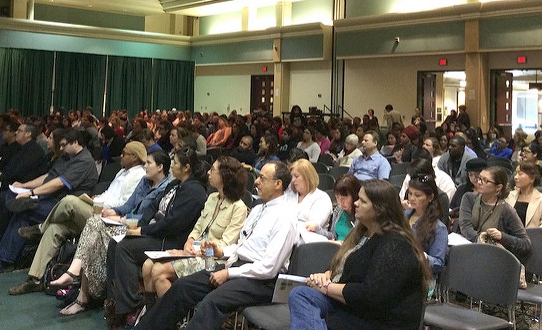 The Multicultural Education Conference at Sacramento State, seen above in 2015, is expected to draw more than 700 attendees this year, organizers say. (Sacramento State file)
The Multicultural Education Conference at Sacramento State, seen above in 2015, is expected to draw more than 700 attendees this year, organizers say. (Sacramento State file)When Duane Campbell organized the first Multicultural Education Conference at Sacramento State in 1995, the goal was to provide a place for alumni of the University’s new bilingual and multicultural education department and others interested in the topic to come together. About 200 people attended, and Campbell, then the department chair and now a professor emeritus, delivered the opening address.
On Saturday, March 30, approximately 700 are expected to attend the now-nationally known conference’s 25th anniversary, a reflection of both a growing focus on multicultural education overall as well as Sacramento State’s role in promoting and supporting it.
The conference is sponsored by the College of Education, and this year’s event will celebrate the past, present, and future of the multicultural education movement.
That movement, says Dale Allender, conference co-chair and assistant professor of education, is an effort to acknowledge perspectives traditionally excluded from the educational system and to take steps to include them while correcting inequities those exclusions caused. People of color, women, LGBTQ individuals and members of disabled communities generally were marginalized and left out.
Correcting that means determining if the curriculum is relevant to a diverse student body and if it shows that all perspectives are equally valued: Do assigned texts include diverse characters, topics and ideas? Can all students relate to the problems and challenges presented in a classroom setting?
“For much of history, education has been one lens and one framework, and the curriculum adopted by the state has been the dominant culture’s perspective,” said Jenna Porter, an associate professor of education and conference co-chair. “Multicultural education acknowledges there are many other perspectives that should all be heard and valued.”
Social and racial justice is woven throughout Sacramento State’s College of Education, including teaching credential courses, Porter and Allender say. The California Teachers Association definition of social justice is adopted into class syllabi, providing future teachers with guidance for how to develop culturally relevant lesson plans, incorporate social justice and tolerance into the classrooms, and work in the community.
K-12 students benefit from multicultural education in multiple ways, Allender said. They become more well-read, less likely to accept misinformation as fact, more likely to have empathy and less likely to offend.
"When you have disparate experiences, where kids don’t see themselves reflected and validated in the classroom, school can cause cognitive dissonance,” Allender said. “Multicultural education says, ‘let’s teach things that are really happening. Let’s find a way to provide something more affirming, relevant and engaging.’ ”
The conference provides individuals from a wide range of groups – Sacramento State students and faculty; students and faculty from other institutions; K-12 teachers, administrators and counselors; and people from nonprofit organizations or the education industry – a chance to come together, network, learn from each other, and hear from industry experts about how to further promote multicultural education.
Throughout the state and beyond, the need for multicultural education is being acknowledged. The result is efforts, some legally mandated, to promote bilingual classes, ethnic studies and culturally relevant K-12 curricula.
That’s a far cry from the political environment when the conference began. As Sacramento State was promoting bilingual and multicultural education, California voters in 1996 overwhelmingly passed Proposition 227, effectively eliminating bilingual classes in K-12 schools. (Much of the measure was repealed in 2016 by the passage of Proposition 58.)
“At the time, bilingualism was seen as divisive,” Campbell said, noting that about 40 percent of California students and 5 percent of teachers then were Latino. “What we were trying to do was train teachers to work with all those bilingual kids in the schools.”
The bilingual and multicultural education department as well as the conference grew. And Sacramento State was – along with California State University, Northridge – unique in making strides to increase the diversity of the teaching workforce.
“About 35 percent of the total teachers in the University were graduating out of bilingual and multi-cultural education, and the conference was a central part of that,” Campbell said. “The conference was part of making a very substantial, substantive change.”
The bilingual and multicultural education department was ultimately eliminated in 2010 when all teaching credentials programs were consolidated into one department.
The University, Campbell says, still has work to do to ensure that its credential graduates match the diversity of the K-12 students they will teach, something Porter and Allender acknowledge. Emphasizing multicultural education through the curriculum – and via the conference, which students, faculty and alumni are welcome to attend – is one way to address the issue so Sacramento State teaching alumni can create inclusive classrooms that celebrate, welcome and acknowledge all perspectives and identities.
“We recognize that our teachers look very different than the K-12 kids they teach,” Porter said. “We’re actively working toward recruiting to diversify the teaching workforce.”
More information is about the Multicultural Education Conference is available on the events web page. – Jonathan Morales
